The impact of home advantage in football

Written by :
Matthew Hanssen

There is no doubt that playing in your own stadium is different and changes the score. There do not seem to be any exact or very objective reasons for this, but there is no doubt that emotions are highly influenced.
It is no coincidence that deciding a decisive or knockout game with home advantage is considered a competitive advantage and, in fact, on many occasions a draw is held to define where the second decisive game will be.
In some championships that have at least two phases, the clubs with the best performance in the first phase (usually a points-based league) have the advantage of playing the second game at their own stadium.
To understand the influence on the result of playing with the home team in your favor, we analyzed almost 1 million football matches from the last ten years in 167 different countries.
And the first result is not surprising. Overall, the home team won 42% of games, while draws occurred in 28.5% of cases, and away team victories represented a very similar figure, at 29.5%.
This trend suggests a significant advantage for teams playing in their own stadiums.
This trend suggests a significant advantage for teams playing in their own stadiums.
There are several factors that can interfere with this advantage, such as familiarity with the field, psychological support from the fans and even the influence of long and tiring trips on visiting teams.
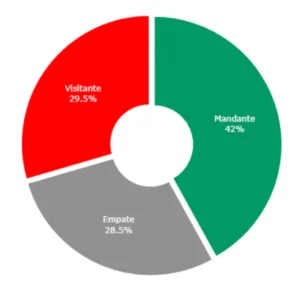
Variation between countries
This advantage varies substantially between different countries. For example, in Guatemala, home teams have an impressive 66% win rate compared to just 24% for visitors.
Similarly, in Algeria, the rate is 61% for home teams versus 29% for visitors. In Brazil, the difference is also quite high: home teams win 54% of games, while visitors win 36% of the time.
In Denmark, the country with the smallest disparity, the home factor has little influence, with a minimum difference of 48% to 44% in favor of the home teams.
These variations may reflect cultural differences, climate differences and even the quality of stadium infrastructure, which can influence team performance.
Among the top five European leagues, Spain has the biggest disparity, with 52% home wins versus 37% away wins. In contrast, Germany has the most balanced scenario, with 49% home wins versus 40% away wins.
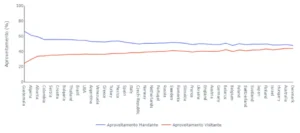
When analyzing the distribution of results by country, it can be seen that, in Guatemala, home clubs won 58% of the games, drew 27% and lost only 15%.
In Belgium, there was the highest percentage of draws (36%), while in Australia, visiting teams won on 37% of occasions, the highest percentage among the countries analyzed.

Evolution over the seasons
Statistics over the seasons show a decreasing trend in home team advantage, indicating an evolution in the balance of the game. The following graph shows how much the probability of winning increases when playing at home.
In 2013, the percentage difference was 42%, falling to 29% in 2023. The progressive decrease in the home team’s advantage may indicate an evolution in the visiting teams’ strategies.
This may reflect better physical and tactical preparation to face the difficulties of playing away from home. It may also indicate an improvement in stadium infrastructure, making playing conditions more uniform across different venues.
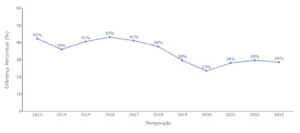
Clubs
Some clubs have notable disparities in their home and away performances. Nigeria’s Katsina United have a 76% home record compared to just 10% away record, and were the club with the biggest difference in performance.

When we filtered only the five most important European leagues (La Liga, Serie A, Bundesliga, Premier League and Ligue 1), Italian giant Juventus was the club with the biggest advantage when playing at home: 84% success at home and 54% away from home.
Other big clubs, such as rivals Arsenal and Tottenham, also appear among the 25 clubs with the biggest gap, highlighting the importance of playing with the support of their fans.

Only 3% of the clubs analyzed perform better away from home than at home, but the difference is usually quite small. The graph below shows only the clubs in the top-5 European leagues.
Metz, Werder Bremen, Burnley and FC Koln were the only clubs with better performance when playing away from home. Big clubs such as Bayern Munich, PSG, Chelsea and Real Madrid showed a small difference in performance between playing at home and away (in the case of these clubs, both performances are high, which indicates high technical quality).

The influence of referees
Referees also seem to play a role in the dynamics of the game. For example, when Tunisian Sadok Selmi is in charge, the home team has a 70% success rate, compared to just 19% for the away team.
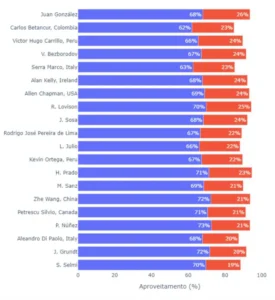
With the Italian Francesco Carrione, the visiting team’s efficiency is 58%, while the home team’s efficiency is 33%. In general, only 15% of referees have a higher efficiency of the visiting team than that of the home team.
Pressure from home fans can unconsciously influence referees’ decisions, favoring the home team. However, this is an area that may warrant further investigation, considering the ethical implications and the integrity of the sport.
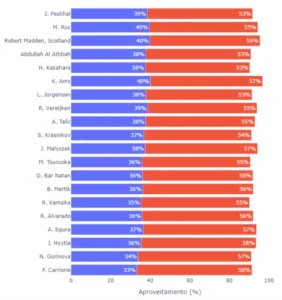
Conclusion
This analysis reveals that while some countries and clubs exhibit a clear home advantage, others exhibit a greater balance, challenging the idea that playing at home is always a significant advantage.
Factors such as team quality, game strategies and referee influence can be just as impactful as the venue of the game.
Furthermore, examining this phenomenon highlights that football transcends skills and tactics, being affected by psychological, cultural and environmental elements.
Recognizing this interplay between various elements can not only enrich understanding of the game, but also provide strategies for coaches and players to maximize their chances of success, regardless of the playing venue.
